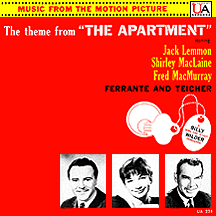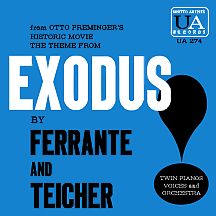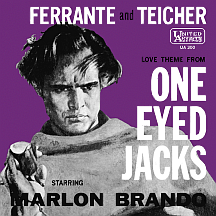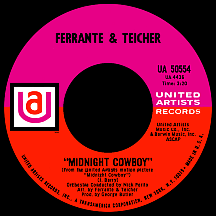FERRANTE AND TEICHER
Piano duets have been a thing for quite some time. 19th century composers including Franz Schubert, Johannes Brahms, Antonin Dvorak and others took on the challenge of crafting music specifically designed for two players sharing one piano. 20th century composers like Maurice Ravel and Igor Stravinsky followed suit, as written works became more compatible with the concept of two pianists complementing one another with parts of the same musical piece played simultaneously on separate pianos, enabling presentations of more complex and sometimes interpretive 176-key performances. Typically the domain of classical musicians (one of the earliest teams, Hungarian brothers Wilhelm and Louis Thern, were "four-hand" practitioners active in the latter 19th century), the technique was seldom applied to popular music. That is, until Ferrante and Teicher came along in the 1940s, playing together on one keyboard before scaling up to separate grand pianos. Their adaptations of popular movie themes, occasional classic works and their own originals established them as one of the most successful instrumental acts of the 1960s.
Both musicians discovered the piano between the ages of two and three, each displaying a knack for picking out songs by ear. Arthur Ferrante, born in New York in 1921, began taking lessons around age six and shortly afterwards was tested for the Juilliard School of Music's Preparatory Center, gaining a full scholarship as a result. Louis Teicher, born in 1924 in Highlands, Pennsylvania, followed the same path to Juilliard a couple of years later. The two became good friends as adolescence approached, at one point finding themselves in a class that taught piano ensemble performance, where the four-hand gimmick took hold. After graduation in 1944, Ferrante joined the Juilliard faculty as a music theory instructor. Teicher arranged a musical, Song of Norway, and even joined the orchestra of the Broadway production, playing all the piano parts. In addition, he formed his own trio (piano, violin and cello), performing in clubs and trying out different ideas to gauge clubgoers' reactions.
In 1947, Arthur and Louis joined the Toledo Symphony Orchestra as dual pianists. Later, they performed in venues large and small, transporting their pianos from state to state in a used delivery truck. Around this time, jazz and classical pianist, movie star and fellow Juilliard prodigy Hazel Scott began exhibiting a variation: she turned the technique inside-out, playing two pianos at once! Ferrante and Teicher began working in New York City nightclubs performing in a variety of styles: jazz, classical, Latin and experimental. Pop standards (including some rapid-fire, tricky pieces that revealed their dexterity) began to seep into the mix as they developed a humorous banter between songs; soon they were being booked for shows throughout North America.
A stint on radio's Piano Playhouse inspired a 1952 MGM label release of the same title. Columbia Records signed the act the same year, billing them as Art Ferrante and Lou Teicher. The album Hi-Fireworks and singles "Susanna's Last Stand" (a frolicsome version of "Oh! Susanna") and "Tabú" were not strong sellers; perhaps the gimmicks that worked so well onstage were a little ahead of the curve for vinyl. Yet Art and Lou delved deeper into creating odd sounds and effects, placing small rubber slabs into their grands for a muted effect and metal parts or even sandpaper between strings to achieve louder results, particularly when they gently pucked or forcefully pounded the keys (this practice is referred to in musicians' circles as "prepared pianos"); audiences were delighted if not a bit baffled. As the '50s began, television was the hottest trend and F&T took advantage, appearing on many variety shows with the full bag of tricks on display, culminating in some spectacular demonstrations on funnyman Ernie Kovacs' mid-'50s show.
Variety was the spice of a series of albums on the Westminster label from '54 through '56, as they played around with classical melodies, Christmas music and show tunes, topping them all with Soundblast, a disc filled with otherworldly effects rooted in the duo-piano technique (packaged with "outer space" artwork and a cover blurb: The sounds of tomorrow today!). A move to the fledgling ABC-Paramount label in 1958 placed them under the supervision of producer Don Costa, where they continued in the space age vein while jumping, briefly, onto the "exotica" bandwagon. Costa left to take a position at the even newer United Artists label, a division of the famous film studio with its initial focus on releasing soundtrack recordings. "Lovers Symphony," a humdrum effort penned by Costa (reminiscent of earlier romantic film music) with an equally mild flip side penned by Art and Lou ("Dream Concerto"), went unnoticed. But as the new decade dawned, so did the fortunes of Ferrante and Teicher.
In the summer of 1960, Costa released his own instrumental cover of the Greek film theme "Never on Sunday" and suggested F&T go the same route. "(Theme from) The Apartment" (Billy Wilder's critically-acclaimed comedy-drama) was adjusted to the duo-piano approach and hit the top ten in September (the movie, starring Jack Lemmon and Shirley MacLaine, went on to win five Oscars including Best Picture). Suddenly the symphonic ivory-pounders were the hottest music act with horn-rimmed glasses since the dear, departed Buddy Holly. Recording sessions were serious affairs: in order to capture the perfect level of interplay between pianists with maximum stereo fidelity, the studio was cleared of anyone who wasn't the producer, arranger or engineer. This procedure continued for years and reaped benefits...millions of them.
The peak came with the theme from "Exodus," an epic film directed by Otto Preminger set to a magnificent music score by Austrian composer Ernest Gold, who would win an Oscar and a Grammy for the film's music just a few months after its release. Late in the year, there was a scramble to cover the theme, with Mantovani competing against F&T. In the early months of '61, their duo-piano version took over, reaching number two on Billboard and number one on Cash Box during a three-month run in the top ten. Mantovani's more traditional take reached the top 40, as did a jazz variation a few months later by Eddie Harris; you couldn't turn on a radio that winter or spring without hearing "Exodus" within minutes, the Ferrante and Teicher smash more often than not.
Seems everyone bought at least one Exodus album (Gold's soundtrack and the Mantovani and Harris longplays all landed at or near the top of the album charts). United Artists didn't have enough material to rush out a Ferrante and Teicher 12-inch, so they capitalized on the single's success in a different way: Great Motion Picture Themes led with "Exodus" and featured "The Apartment" plus other hits on the label (Costa's "Never on Sunday" and "The Magnificent Seven" by guitarist Al Caiola), in addition to 12 other themes from high-profile films, a loaded collection that reached number two on the LP charts.
Sudden demand kept Art and Lou on a busy schedule, literally for years. Touring seemed nonstop, though ample studio time was allowed. One Eyed Jacks, a western film directed by and starring Marlon Brando, had its own "Love Theme" (penned by cellist and film composer Hugo Friedhofer) and the F&T recording reached the top 40 in April. The ten-times-Oscar-winning West Side Story supplied material for another top ten hit; "Tonight" (the piano duo accompanied by a vocal chorus this time) gave them an excuse to release two album tie-ins (one titled after the film and the other after the hit song) that mostly contained material from other films, yet were their highest-charting albums. They, and UA, had figured out how to lucratively position their product.
Besides about two dozen previous albums on other labels, there were more than 60 recorded for United Artists during the duo's 20 year association with the company; charting two, three or four LPs at any given time became a routine for several years. Musical selections were chosen from the soundtracks of top-grossing box office and/or award-winning films representing an abundance of top-ranked composers, such as (but not limited to) Leonard Bernstein and Stephen Sondheim, Charles Chaplin, Franz Waxman, Maurice Jarre, Alex North, Riz Ortolani, Michel Legrand and John Barry. The pianists supreme became the main priority in United Artists' barrage of popular soundtracks and original movie-related releases that included Barry's many James Bond scores (Dr. No, From Russia With Love and Goldfinger, just for starters) and the multi-million-selling Beatles soundtrack A Hard Day's Night.
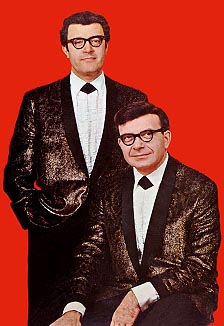
Some of the more prominent singles by Ferrante and Teicher in the decade's middle years (all of which landed on national sales charts) include versions of Franz Waxman's "Taras Bulba (The Wishing Star)" in '62, Maurice Jarre's "(Theme from) Lawrence Of Arabia" and Alex North's "Antony and Cleopatra Theme" in '63. An original composition by Art and Lou made a brief appearance on the "easy listening" chart that year, a ditty titled "Crystal Fingers." Other films getting the treatment include "The Seventh Dawn" (Paul Francis Webster and Riz Ortolani, 1964), 1965's "The Greatest Story Ever Told" (Alfred Newman) and "The Knack" (John Barry), as well as the similar but fabulous themes by Francis Lai from the French films "A Man and a Woman" (1966) and "Live For Life" (1967).
One of their biggest hits came in late '69 with a cover of Barry's theme from "Midnight Cowboy." The original soundtrack recording featured prominent harmonica, but Ferrante and Teicher took their arrangement in a different direction, bringing on session guitarist Vincent Bell (real name Vincent Gambella), a designer of guitars for the Danelectro company who shared F&T's interest in unique and unusual musical sounds. Bell came up with a "water drops" guitar effect (that only he had figured out how to implement) and it was featured on the single, which worked its way to a top ten placement in January 1970. Though not credited, "Vinnie" had a hit under his own name just a few months later, using the same "water" sound: "Airport Love Theme," composed by Alfred Newman for the widescreen blockbuster Airport.
The United Artists era came to an end in 1979, after which Art and Lou spent a few years performing concerts with nothing more than the two pianos onstage, allowing them to show off all the interesting effects they could achieve without accompaniment. Fans often requested they make records in the same style, bypassing the orchestras that had been such a large part of their many spectacular recordings. In 1983 they started their own label, Avant-Garde, giving the fans what they'd asked for. The dual career of 176-key tricksters Ferrante and Teicher continued for another 20 years, adding up to well over a half-century in show business since they'd joined forces in 1947. You could say they enjoyed working together almost all of their lives...since they'd met during childhood...at the prestigious Juilliard School.
NOTABLE SINGLES:
- Susanna's Last Stand - 1952
- Beezwhacks - 1952
- Tabú - 1953
as Art Ferrante and Lou Teicher - Che Si Dice (Keh See Deechay) - 1958
- Aflame - 1958
- Lovers Symphony - 1959
- (Theme from) The Apartment - 1960
- Exodus - 1961
- (Love Theme from) One Eyed Jacks - 1961
- Goodbye Again - 1961
- Tonight - 1961
- Smile - 1962
- Lisa - 1962
- (Theme from) Taras Bulba (The Wishing Star) - 1962
- (Theme from) Lawrence Of Arabia - 1963
- Antony and Cleopatra Theme - 1963
- Crystal Fingers - 1963
- The Seventh Dawn - 1964
- The Greatest Story Ever Told - 1965
- The Knack - 1965
- Khartoum - 1966
- (Theme from) The Bible - 1966
- A Man and a Woman (Un Homme et Une Femme) - 1966
- Live for Life (Vivre Pour Vivre) - 1967
- Midnight Cowboy - 1969
- Lay Lady Lay - 1970
- Pieces of Dreams - 1970
- The Music Lovers (Main Title) - 1971
- (Love Theme From) The Godfather - 1972


